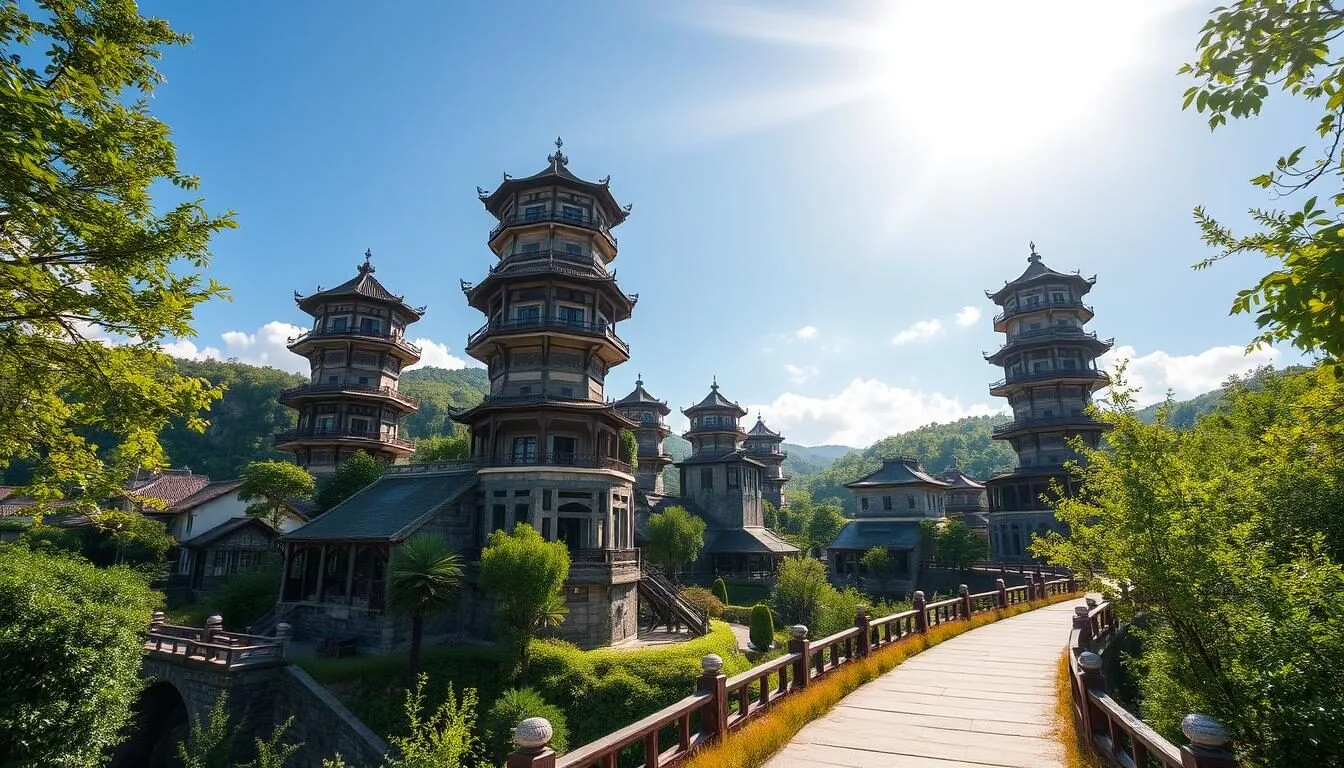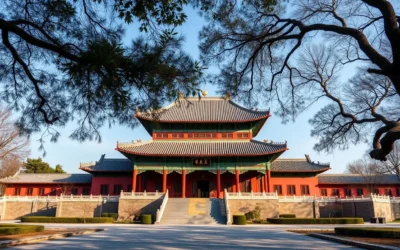✓ Accommodations✓ Flights✓ Rental Cars
You might be surprised to learn that the Kaiping Diaolou, a UNESCO World Heritage Site, is home to over 1,800 watchtowers that blend Chinese and Western architectural styles.
Located in the Guangdong Province, this fascinating cultural treasure was built by returning Chinese emigrants in the early 20th century to protect their families and showcase their wealth.
As you explore the four main diaolou villages – Zili Village, Majianglong, Jinjiangli, and Sanmenli – you’ll uncover the rich history and cultural significance of these structures.
Whether you’re planning a tour or simply want to learn more about this incredible site, you’ll find that Kaiping’s unique blend of cultures and architectural styles is sure to captivate.
Discovering Kaiping: A Hidden Gem in Guangdong Province
As you explore the Guangdong Province, you’ll discover Kaiping, a hidden gem waiting to be uncovered. Located west of the Pearl River Delta, Kaiping is a city with a rich history and cultural heritage.
![]()
Kaiping’s unique position as a cultural crossroads has made it a fascinating destination. The city’s history is deeply intertwined with the Overseas Chinese community, with many of its residents emigrating to various parts of the world, including Hong Kong, Southeast Asia, Australia, and the Americas.
The Pearl River Delta’s Cultural Treasure
The Pearl River Delta region has played a significant role in Kaiping’s development, making it a strategic point for trade and emigration throughout history. You can explore how this location contributed to the city’s cultural and economic growth.
- Understand the historical significance of Kaiping’s location in the Pearl River Delta.
- Learn about the city’s role in the global Overseas Chinese diaspora.
Kaiping’s Overseas Chinese Heritage
Kaiping is renowned for its Heritage Site status, thanks to the distinctive diaolou towers that dot the landscape. These structures are a testament to the city’s cultural exchange with the West, brought back by returning emigrants who infused local architecture with Western influences.
The diaolou towers are not only a symbol of Kaiping’s identity but also a major draw for visitors from around the world. You can appreciate the unique blend of Eastern and Western architectural styles that define the city’s landscape.
Understanding the Diaolou: Kaiping’s Unique Watchtowers
The Diaolou of Kaiping are more than just watchtowers; they are testaments to the ingenuity and prosperity of returning Chinese emigrants. These structures, built primarily in the 1920s and 1930s, served dual purposes: they were both defensive strongholds and status symbols for the wealthy families who built them.
History and Purpose of the Diaolou
The Diaolou were constructed during a tumultuous period in Chinese history, serving as protective fortresses for families against bandits and warlords. Their fortified entrances, narrow windows, and ability to seal off each floor independently made them effective defensive structures. The Diaolou also showcased the wealth and status of their owners, featuring elaborate architectural designs that blended Chinese and Western elements.
| Feature | Description | Significance |
|---|---|---|
| Fortified Entrances | Strong doors and reinforced structures | Provided security against intruders |
| Narrow Windows | Slit windows for observation | Allowed for defense while minimizing exposure |
| Sealable Floors | Each floor could be isolated | Contained threats within a specific area |
Architectural Significance and UNESCO Status
The Diaolou of Kaiping are not only remarkable for their historical significance but also for their unique architectural style, which combines elements of Chinese and Western architecture. This blend is a testament to the cultural exchange that occurred as Chinese emigrants returned with new ideas and technologies. In 2007, the Kaiping Diaolou and Villages were designated a UNESCO World Heritage Site, recognizing their cultural and historical importance.

This UNESCO designation has helped preserve the Diaolou for future generations, ensuring that these remarkable structures continue to stand as a testament to Kaiping’s rich cultural heritage.
How to Get to Kaiping, China

You can reach Kaiping, China through several convenient travel routes. Whether you’re coming from a major city like Guangzhou or neighboring regions such as Zhuhai and Macau, there are multiple transportation options to suit your needs.
From Guangzhou
The journey from Guangzhou to Kaiping takes around 2 hours by bus. The cheapest way to get there is by bus from Fangcun Bus Station (芳村汽车站), which is located a short walk across an overhead bridge from Exit B of Kengkou Metro Station ( ) on Line 1. This convenient connection makes it easy to plan your trip to Kaiping.
From Zhuhai and Macau
There are direct buses from Zhuhai to Kaiping, taking around 2-2.5 hours depending on traffic. These buses drop you off right by Gongbei Port, making for easy passage to Macau and beyond. This route is particularly convenient if you’re exploring the region or have a tour planned that includes multiple destinations.
Private Transport Options
If you prefer a more personalized service, you can hire a driver or join a day tour from Guangzhou. While this option will set you back at least USD $100 per person, it’s ideal for visiting multiple diaolou sites in one day, especially if you’re short on time or prefer the convenience of a guided city tour.
By understanding your transportation options, you can better plan your visit to Kaiping and enjoy the unique cultural heritage this city has to offer.
Zili Village: The Crown Jewel of Kaiping Diaolou
![]()
As the largest and most famous cluster of diaolou in Kaiping, Zili Village is a treasure trove of history, architecture, and natural beauty. This idyllic village is characterized by its watchtowers scattered among lush rice fields and serene lotus ponds, creating a unique landscape that is both breathtaking and historically significant.
Exploring the Fang Clan Watch Tower
The Fang Clan Watch Tower is one of the standout attractions in Zili Village, exemplifying the unique architectural styles that blend traditional Chinese and Western influences. Visitors can climb to the roof of this impressive structure to enjoy panoramic views of the surrounding countryside, gaining a deeper appreciation for the region’s cultural heritage.
Film Location of “Let the Bullets Fly”
Zili Village gained international recognition as the filming location for the hit Chinese movie “Let the Bullets Fly,” starring Hong Kong-born actor Chow Yun-fat, who has ancestral roots in Kaiping. This exposure has drawn more visitors to the village, eager to experience the beauty and history that captivated audiences worldwide.
Best Photo Spots in Zili Village
With its picturesque landscapes and unique watchtowers, Zili Village offers numerous opportunities for capturing stunning photographs. Visitors can explore the village to discover the best photo spots, from the tranquil lotus ponds to the majestic watchtowers set against the backdrop of lush rice fields.
Zili Village is considered the essential first stop for any visitor to the Kaiping diaolou region, offering an unforgettable experience that combines history, architecture, and natural beauty. As you explore this enchanting village, you’ll discover why it’s regarded as the crown jewel of Kaiping’s diaolou.
Li Garden: A Blend of Eastern and Western Architecture
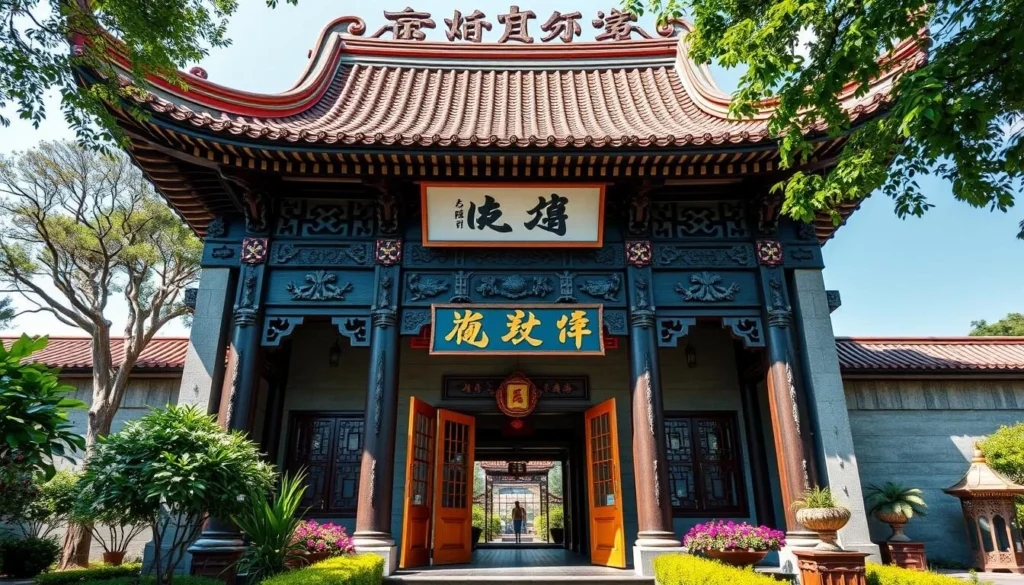
Step into Li Garden, and you’ll be transported to a world where traditional Chinese and Western influences blend seamlessly. Constructed in 1936 by Mr. Xie Weili, a Chinese emigrant who returned from the United States, this spacious garden is a treasure trove of cultural heritage.
The Story of Xie Weili
Xie Weili’s journey is a fascinating tale of success and cultural exchange. After making his fortune in America, Xie returned to his hometown with a vision to build a garden that would reflect his experiences abroad. The result is Li Garden, a beautifully preserved complex that showcases multiple diaolou, each with its unique architectural style.
Highlights of the Garden Complex
As you explore Li Garden, you’ll discover a collection of well-preserved diaolou, each belonging to a different family. The garden is particularly notable for its western architectural styles, with a strong French influence evident in the design. Inside the diaolou, you’ll find authentic period furniture and household items, offering a glimpse into the lifestyle of the wealthy returning emigrants.
The ancestral hall within the complex is another significant cultural element. This is where families would honor their forebears, and it remains an important part of the garden’s heritage. Li Garden, though not part of the UNESCO World Heritage Site, is considered by many visitors to be the most impressive place to experience the diaolou culture.
Visiting Li Garden is a must for anyone interested in history, architecture, and cultural heritage. Be sure to check the opening hours to plan your visit accordingly. With its unique blend of Eastern and Western styles, Li Garden is a true gem in Kaiping’s cultural landscape.
Majianglong Village Cluster: Diaolou Among Bamboo Forests
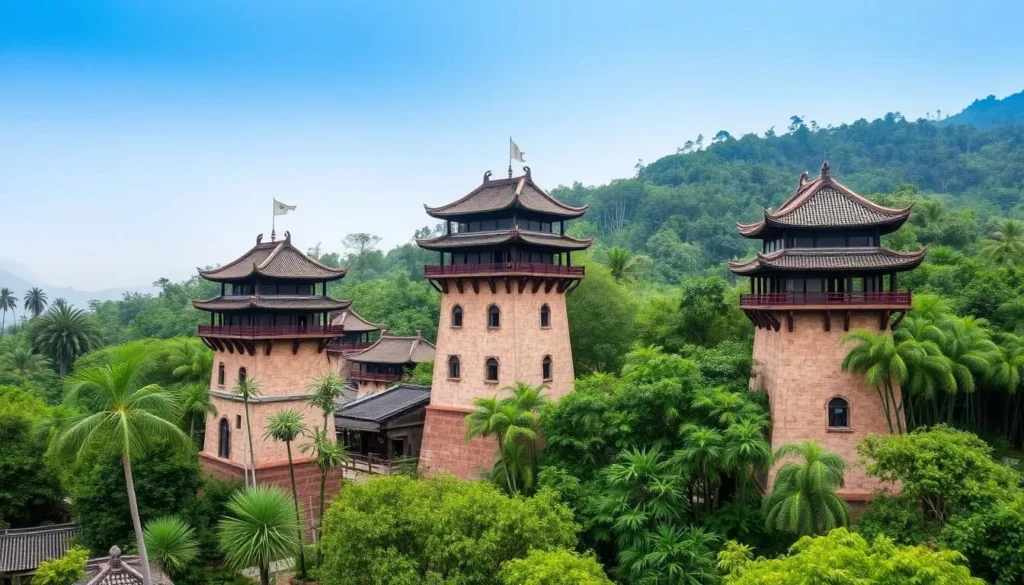
Nestled within a lush bamboo forest, the Majianglong Village Cluster is a breathtaking destination that showcases Kaiping’s unique Diaolou watchtowers. This scenic area is not only a testament to the region’s rich cultural heritage but also a haven for nature lovers and photographers alike.
Unique Features of Majianglong’s Watchtowers
The Diaolou watchtowers in Majianglong are distinct for their integration into the surrounding landscape. Unlike other Diaolou sites, these watchtowers emerge dramatically from the dense bamboo forests, creating a surreal and picturesque scene. Climbing to the top of these watchtowers rewards visitors with a spectacular view of the surrounding landscape, where other towers peek through the bamboo canopy.
Exploring the Surrounding Natural Landscape
The Majianglong village is strategically positioned, with mountains protecting the rear and the Tanjiang River serving as a natural boundary at the front. This unique setting not only provided a secure location for the villagers in the past but also makes it an ideal spot for those looking to explore the natural beauty of the area. The bamboo forests surrounding the village add to its charm, creating a tranquil atmosphere that is a welcome respite from the hustle and bustle of city life.
The picturesque setting of Majianglong made it an ideal filming location for scenes in the popular Chinese film “Let the Bullets Fly.” Visitors can explore the village and its watchtowers, experiencing firsthand the unique blend of natural beauty and architectural heritage that made it a favorite among filmmakers.
Jinjiangli Village: Home to Kaiping’s Tallest Diaolou
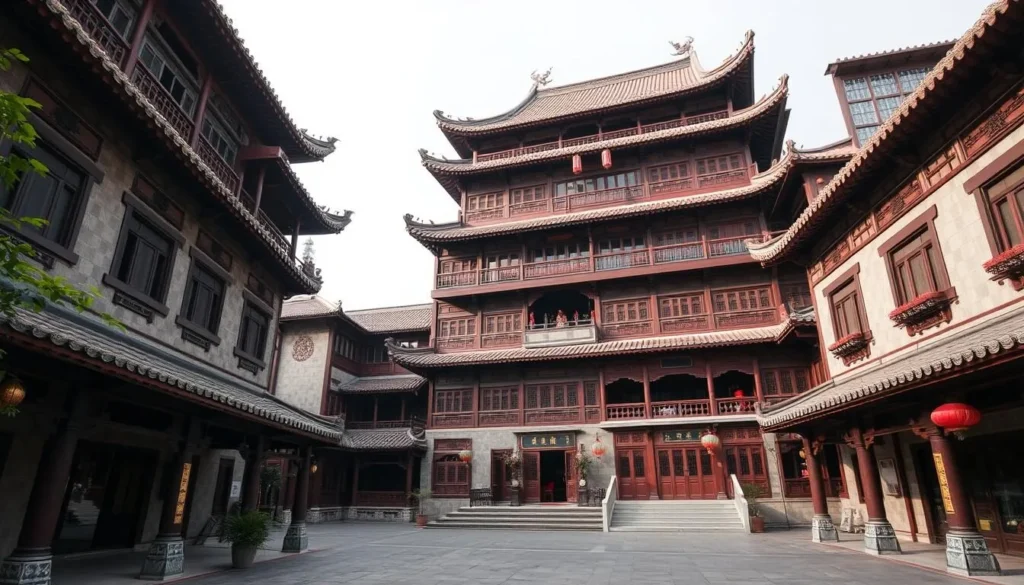
As you explore Kaiping, you’ll discover Jinjiangli Village, home to the tallest diaolou in the region. This village, while similar in size to Zili Village, boasts fewer but more elaborately decorated diaolou buildings, making it a unique cultural and architectural gem.
Ruishi Lou: The Nine-Story Marvel
Ruishi Lou stands as the crowning jewel of Jinjiangli Village, reaching an impressive nine stories high. Its architecture is a fascinating blend of Chinese and European styles, featuring a Byzantine-style roof and a Roman dome, setting it apart from other diaolou in Kaiping. Visitors can explore the interior, which includes living quarters, kitchens, bedrooms, and notably, the ancestral hall located on the top floor, a common feature in these traditional structures.
Other Notable Structures in Jinjiangli
Apart from Ruishi Lou, Jinjiangli Village is home to other significant diaolou, including Shengfeng Lou and Jinjiang Lou. Each of these towers has its own architectural character, contributing to the rich cultural tapestry of the village. The interiors of these structures provide a glimpse into the traditional way of living, with detailed layouts that include various domestic spaces and the revered ancestral hall.
The diaolou in Jinjiangli Village are not just defensive structures; they are testaments to the cultural exchange and architectural innovation that have shaped Kaiping’s heritage. As you explore these impressive buildings, you’ll gain a deeper understanding of the historical context and the people who built them.
Sanmenli Village: The Oldest Diaolou in Kaiping
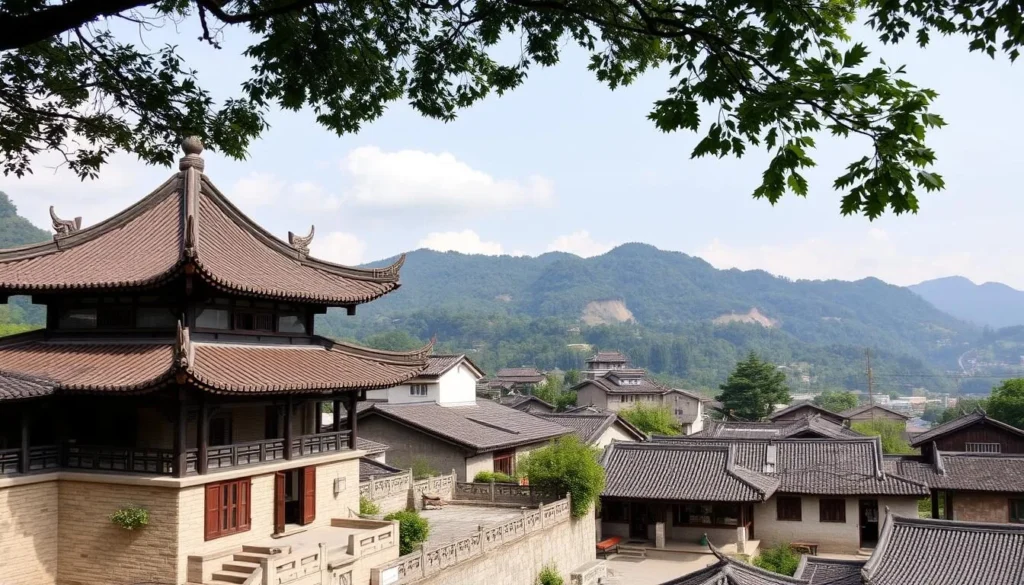
If you’re looking for an authentic experience in Kaiping, head to Sanmenli Village, where tradition meets history. Located to the northeast of Chikan, Sanmenli is a UNESCO-designated village that’s home to Yinglonglou ( ), the oldest remaining diaolou in Kaiping.
Yinglong Lou and Its Ming Dynasty Origins
Built by the Guan family during the Ming Dynasty (1522-1566), Yinglong Lou is a three-story fortress that showcases the evolution of diaolou architecture over time. This ancient structure differs significantly from later diaolou, providing valuable insights into the history of these unique watchtowers.
Traditional Village Life in Sanmenli
Sanmenli Village offers a glimpse into traditional rural life in China. As you walk through the village, you’ll see elderly residents going about their daily routines, providing a unique opportunity to experience authentic village life. However, the village faces demographic challenges as younger residents have migrated to big cities, leaving behind a predominantly older population.
Chikan Old Town: A Glimpse into Kaiping’s Past
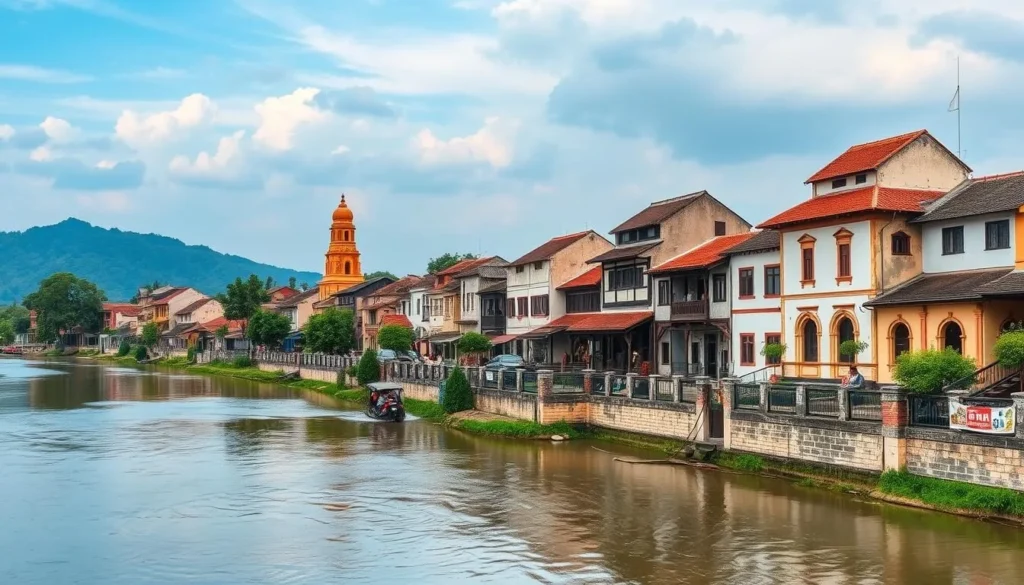
As you step into Chikan Old Town, you’re transported back in time to an era when this town was a thriving market hub. Historically, Chikan was the administrative center of Kaiping and one of the largest market towns in South China during the 1930s. Located on the banks of the Tan River, it was not only a commercial hub but also a picturesque old town that attracted visitors.
Current Renovation Status and Future Plans
Until a few years ago, Chikan Old Town was a deserted yet picturesque site. As of mid-2018, the town was largely abandoned, but the government has since initiated a major renovation project planned to span at least five years. This renovation aims to restore the historic homes and potentially boost tourism in the area.
Historical Significance of Chikan
Chikan, which translates to “red pit,” has a rich history that is worth exploring. Years ago, it was a bustling marketplace, and its location on the Tan River made it an ideal spot for trade. Even during its abandonment, the town provided interesting photo opportunities, capturing the essence of a town in transition.
Kaiping, China: Best Things to Do – Top Picks for Different Schedules
Whether you’re visiting Kaiping for a day or a weekend, we’ve got you covered with our top picks for experiencing the best of this historic city. Planning your trip according to your schedule will help you make the most of your diaolou tour.
One-Day Itinerary: The Essential Diaolou Experience
If you only have one day to explore Kaiping, we recommend visiting the three core diaolou sites using the convenient free shuttle bus service. Start your day at Kaiping Yici Bus Station and take Bus 617 to Zili Village (approximately 45 minutes). From there, take the free shuttle bus to Li Garden (about 10 minutes away) and then to Majianglong (around 25 minutes). Finally, take Bus 613 back to Kaiping Yici Bus Station (about 45 minutes). This route allows you to see the most impressive diaolou while making the most of your day.
For an optimal experience, consider allocating about 2 hours to explore Zili Village, 1.5 hours at Li Garden, and another 1.5 hours at Majianglong. This will give you ample time to appreciate the architecture and history of these UNESCO-designated sites.
![]()
Two-Day Comprehensive Tour
If you have two days to explore Kaiping, you can enjoy a more leisurely pace and visit additional diaolou sites included in the all-in-one ticket, such as Jinjiangli and Nanlou, or even venture to Sanmenli. This will give you a deeper understanding of Kaiping’s cultural heritage and allow you to appreciate the unique features of each village.
With more time at your disposal, you can also explore the surrounding natural landscapes and immerse yourself in the local culture. Take your time to wander through the villages, interact with the locals, and enjoy the serene environments that make Kaiping such a special destination.
By planning your visit according to your schedule, you can ensure a memorable and enriching experience in Kaiping. Whether you have one day or two, the city’s diaolou villages are sure to leave a lasting impression.
Practical Information for Visiting Kaiping’s Attractions
For travelers heading to Kaiping, having the right information about ticket prices, transportation, and the best times to visit can greatly enhance their experience. Understanding these practical aspects will help you plan your trip more effectively and enjoy the beauty and history of Kaiping’s Diaolou watchtowers.
Ticket Prices and Combination Passes
Visiting Kaiping’s Diaolou sites can be a bit pricey if you buy individual tickets. However, the cost can be significantly reduced by purchasing combination passes. For instance, the comprehensive 5-site pass, priced at 180 RMB, is valid for two days and includes entry to major attractions like Zili Village, Li Garden, and Majianglong. There’s also a 2-site pass available for 150 RMB, valid for two days. Seniors over 60 can enjoy half-price entry upon presenting their ID.
| Ticket Type | Price (RMB) | Validity | Sites Included |
|---|---|---|---|
| Comprehensive 5-site Pass | 180 | 2 days | Zili Village, Li Garden, Majianglong, and 2 other sites |
| 2-site Pass | 150 | 2 days | 2 selected sites |
Transportation Between Sites
One of the conveniences of buying a combination pass is the access to a free shuttle bus service. This service runs between Zili Village, Li Garden, and Majianglong seven times a day, making it easier for you to visit these sites without worrying about transportation. The operating hours for the shuttle bus align with the opening hours of the attractions, typically from 8:30 AM to 5:30 PM.
Best Time to Visit
The best time to visit Kaiping is during the spring and autumn seasons when the weather is pleasant, making it ideal for a tour of the outdoor sites. These seasons offer comfortable temperatures and fewer rainy days, ensuring that your visit is enjoyable and that you can fully appreciate the beauty of the Diaolou and their surroundings.
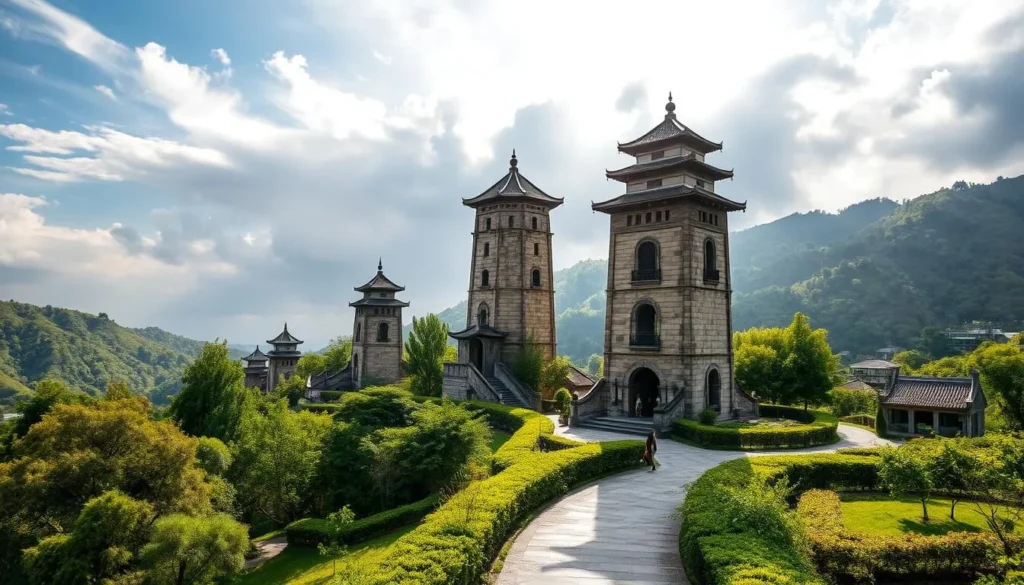
Where to Stay in Kaiping
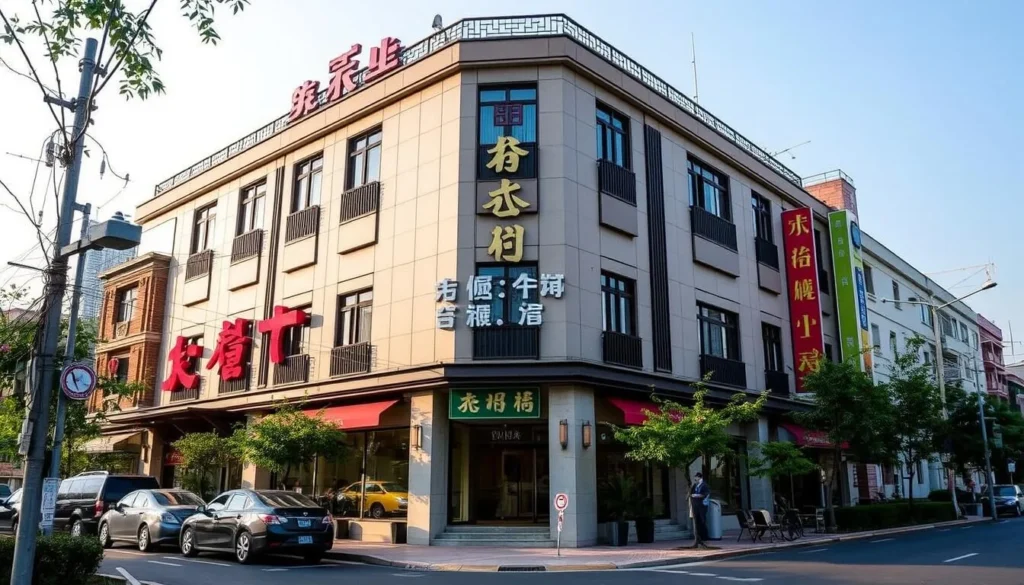
When visiting Kaiping, choosing the right place to stay is crucial for a smooth and enjoyable trip. The best base for exploring the Diaolous is Yici Bus Station, also known as Kaiping Passenger Station.
Accommodations Near Yici Bus Station
Staying near Yici Bus Station provides the most convenient access to the Diaolou sites and other transportation options. You can find budget-friendly hotel options within walking distance of the bus station, including business hotels that accept foreign guests.
Other Lodging Options in Kaiping
While the 5-star Pantower International Hotel is the most upscale hotel in the city, it’s located on an island in the river, making it less convenient for accessing Yici Bus Station, which is 4km away. Consider the trade-offs between staying at more upscale accommodations versus more conveniently located but simpler options.
Conclusion: Experiencing the Cultural Heritage of Kaiping
Kaiping’s Diaolou villages are a testament to the region’s cultural significance and its people’s resilience. As a UNESCO World Heritage site, these structures represent an important chapter in Chinese architectural history and overseas Chinese heritage.
Visiting Kaiping offers a unique opportunity to explore a lesser-known aspect of China’s relationship with the outside world. The Diaolou villages tell the story of emigration, return, and cultural exchange, providing insights into the lives of those who built these remarkable watchtowers.
For many overseas Chinese with ancestral connections to the region, visiting Kaiping is a meaningful way to connect with their heritage. The preservation of these UNESCO World Heritage sites ensures that future generations can continue to experience this remarkable cultural landscape.
As you visit the Kaiping Diaolou villages, you’ll be struck by the blend of traditional and modern elements, a true reflection of the region’s history and cultural identity. The Kaiping Diaolou villages are a must-see destination for anyone interested in cultural heritage and history.
In conclusion, Kaiping’s cultural heritage is a treasure that continues to captivate visitors from around the world. By exploring the Diaolou villages, you’ll gain a deeper understanding of the region’s significance and the importance of preserving our cultural heritage for future generations.
The above is subject to change.
Check back often to TRAVEL.COM for the latest travel tips and deals.
